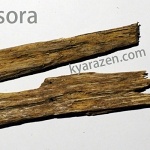Hello all, Just a public service announcement. My web administrator had been updating me with potential site attacks, logins, and bots trying to trawl/dig my website, with also many people from all over the world saving my pages, downloading all my images etc. There are also various merchants, vendors, that have my website hyperlinked in… [Read More…]
The Best Day of the Year to Make Incense
The above statement is one that has been passed down in Chinese Incense culture records. The translation of it roughly means : Fragrant herbs are born from the culmination of pure Yang, it is the embodiment of pure Yang. The Fifth Day of the Fifth Lunar Month, is a festival celebrated by the Chinese. It… [Read More…]
Two controversial identities of Golden Silk Kynam
金丝奇楠, or Golden silk kynam in modern day suffers two controversial identities. Under modern grading of authentic kynam, high end dealers in Hongkong occasionally classify some kynams as golden silk kynam due to the golden silky streaks of resin present in the wood, with the other grades being silver silk, coffee kynam, or simply normal… [Read More…]
Usage of Kynam or Kyara in the naming of modern Incense products
In the recent years, there are many incense products on the market that are marketed as “kynam incense” or “kyara incense”, of which many consumers are easily convinced to make a purchase without reading the fine prints. It seems that the Japanese incense companies are the only ones making incense with kyara/kynam, with some sticks… [Read More…]
Burning Incense Powders as trails without Makko
Ever tried to burn a scoop or a mound of incense powder (sandalwood, agarwood etc) in a saucer or an incense burner and not have it combust to completion, often smouldering, smelling charred and too smokey? That happens because of the lack of proper access to air for complete combustion of incense powders if… [Read More…]
Incense and fragrance for therapeutic purposes
Both scent and taste are sensed by a family of transmembrane proteins known as G-protein coupled receptors. But sparing you the boring science, I thought that this article could be a good follow up to the Rikkoku post I had last week, where agarwood notes are described as tastes. In principle the best way to… [Read More…]
Perspectives on the Rikkoku Gomi
The Rikkoku Gomi set was first assembled around the 15th Century with the establishment of a formalized “way/art” of the Incense by founder Sanjonishi Sanetaka (1455-1537 AD), a noble under the Muromachi Shogunate of Shogun Ashikaga Yoshimasa. Without the benefits of modern logistics, and being more isolated from the rest of the world, agarwood import… [Read More…]
Mukasa-no-Takimono – The Six Kneaded Incenses of the Hei-an Period
Kneaded incense was thought to be brought into Japan by Buddhist Monk, Gan-Jin around 750 AD. From its introduction in the midst of the Nara Period (710 AD to 794 AD) to the Hei-an Period (794-1185), kneaded incense gained immense popularity and it was the norm for the rich and noble to take part… [Read More…]
To all Singapore-based Agarwood and Incense Lovers
My website administrator had informed me that there had been quite some traffic to my website from Singapore! It excites me to know that there are potentially people in Singapore whom are into incense/agarwood/fragrances! If you are from Singapore, please contact me through the contact page, and perhaps, one day, we might be able to… [Read More…]
Making Kneaded Incense Balls – Neri-Koh
The art of making kneaded incense balls dates back over a thousand years ago during the Chinese Tang Dynasty and the corresponding Hei-an period in Japan. Prior to usage in incense culture, honeyed pills (练丹) made from combining medicinal herbs with honey, and sealing off with wax, was a common practice in Chinese medicine. The… [Read More…]
- « Previous Page
- 1
- …
- 7
- 8
- 9
- 10
- 11
- Next Page »







